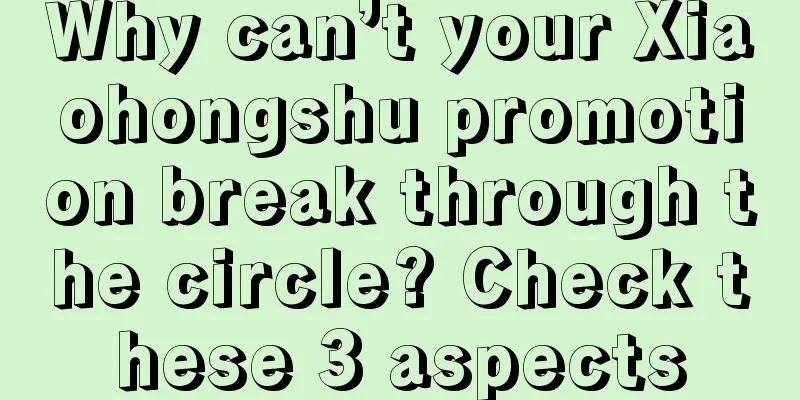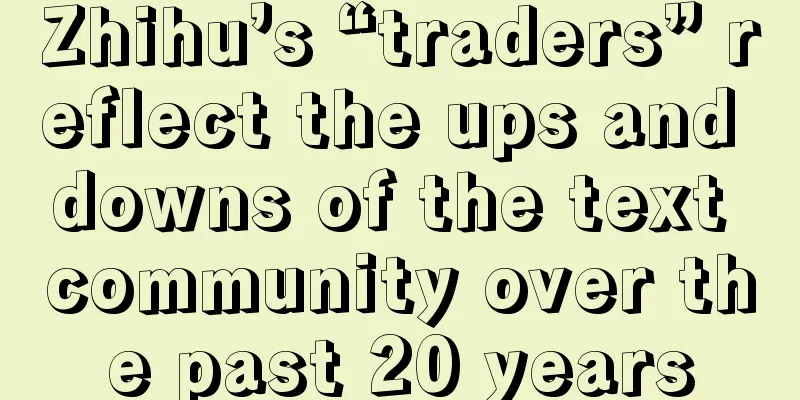Why can’t your Xiaohongshu promotion break through the circle? Check these 3 aspects

In 2024, Xiaohongshu, whose e-commerce business is becoming increasingly mature, has received more and more attention from brands. But at the same time, we also found that there are still many people who have only a vague understanding of the "crowd anti-funnel model", a basic compulsory course for marketing on Xiaohongshu. Common questions include: If the audience is so small, will the coverage be relatively low? The brand potential is created, but what about the kinetic energy? What action should be taken after a reverse funnel cycle is completed? If the marketing investment is not continuous, will it not generate compound interest? Ultimately, it’s all about the trade-offs and concerns between precision and scale, certainty and incremental potential. This time, we will combine 4 specific cases, not talk about terminology and models, but combine psychology, get back to the essence, and use a simpler way of thinking to see how crowd anti-funneling works and why it is possible to balance the above two seemingly "both want and want" trade-offs. 1. Why should the funnel be reversed?Before talking about the anti-funnel, let’s first reach a consensus - the essence of advertising is to create influence. Whether it is by influencing cognition and emotion to influence the association, attitude and desire towards the brand, or by influencing the decision-making process to influence purchasing behavior, the essence is to influence the consumer's mental and behavioral processes. But now, the nodes of influence are becoming more numerous and more dispersed. Because the balance of supply and demand is gradually tilting towards consumers, with more choices, consumers have a higher voice. And with the rise of social media, the desire of individuals to express themselves has been greatly released. When information becomes more and more complicated, it is human nature to trust individual, fresh people more than institutions. In summary, a difficult problem facing brands today is “I don’t care what you think, I care what I think”, that is, the company’s words do not count, only the consumers’ words count. In this case, for brands, how to "influence people through people" becomes the key, which is also the core idea of the reverse funnel model. And word of mouth is the key to "people influencing people". As Daojie proposed in Kinetic Energy Theory 4.0, the crowd operation of new marketing is not over after the user makes a purchase. There is still a lot of work to be done from cognition to recommendation, so R1-R3 (repurchase, re-love, recommendation) needs to be added. Throughout the user journey of A1-R3, there are many opportunities and nodes for word of mouth to play a role. People will first "recognize" a brand through recommendations from others, complete "inquiries" by asking questions in others' notes, and complete "recommendations" in the process of sharing their lives. Good winds can help me soar to the sky. Turning the funnel upside down and letting consumers speak can unleash the power of word-of-mouth to the greatest extent. This is also what word-of-mouth should mean: verbal praise from everyone. So, if the traditional positive funnel is a large opening "pouring inwards", pouring information, the reverse funnel is a small opening "expanding outwards", expanding word-of-mouth. So, where does word-of-mouth come from? The starting point is the core group. This is why some brands have begun to customize products for the core group. Cars are a representative product of durable goods with high technology content and long decision-making cycles. Before finally paying for the car, consumers often have to do their homework, experience it on site, read reviews, study parameters, and repeatedly ponder and compare. But even in such an industry where sellers seem to be more powerful and buyers have less information, more and more attention is paid to core and segmented groups. The new energy vehicle brand "ARCFOX" focuses on the new parent-child track and launches its first car - the Arcfox Koala, which is such an example. This is the first compact new energy MPV (multi-purpose vehicle) that focuses on the needs of vertical groups of people. The product has been aimed at mothers and babies since the research and development stage. For example, the left rear child seat is equipped with an exclusive monitoring camera, the back row is equipped with "teeth-grade chewing" environmentally friendly materials, and the cabin environment is close to 0 aldehyde and 0 benzene.
This is a more proactive and positive response to user needs, requiring brands to not only focus on products, but also on the consumers behind the products - why do they need this product? What problems do they want to solve? A car is not just a machine, but also a carrier for family travel scenarios. After locking in the target group, Jihu Koala launched its own crowd reverse funnel on Xiaohongshu: 1. Starting from the “maternal and infant consumer group” who have purchased maternal and infant products and are determined to be the target group, the core message of “baby-raising helper” is delivered; 2. Expand to core mother and baby groups such as those who are pregnant, preparing for pregnancy, or have children, and convey the message of "the most powerful baby stroller on earth"; 3. Then move on to the search groups for family life, cars, and those with a general interest in mothers and babies, etc. In the end, Arcfox Kaola increased its penetration rate among core maternal and infant population by 825% year-on-year, and its brand search index rose by 1277%, making it the brand with the fastest growing SPU of a single vehicle model in the history of Xiaohongshu. It is worth mentioning that in this process, the brand attracted many “tap water” and naturally wrote more than 20,000 notes. In other words, it successfully involved users and made them part of the brand’s diffusion influence. 2. The first step of the anti-funnel: find the core groupOf course, not every product is like Arcfox Koala, which has a clear core group since its inception. What should be done at this time? We believe that the core group can be regarded as a link between the upper and lower circles. Upward, it connects to the product, and downward, it connects to the high-potential group. That is, upward, they are closest to the product, have the most urgent needs, and have the strongest desire to buy. Downward, they have a strong persuasive power on the larger circle and can influence the high-potential group. In other words, the core group must meet two conditions: be the product's mentor, and have influence and trust. The former will vary greatly depending on the product, so we will mainly discuss the latter here. Psychologist Robert B. Cialdini once summarized the six principles behind persuasion in his book "Influence", three of which are very suitable here. 1. Peer persuasion: We are more likely to conform to the beliefs and behaviors of people who are similar to us. 2. Obeying authority: There is strong pressure in society to obey the demands of authority. The influence of authority comes from being seen as holding power or being an authority. 3. Preference: People tend to agree to requests from people they know and like. To sum up, there are three types of people who can be very persuasive to us: people who are similar to us, experts and people who have experienced it, and people we like. It sounds a bit abstract, so let's take Chadian Milk as an example. This is a local milk brand. In 1953, Premier Zhou Enlai established the state-owned "Chadian Farm". It is an old dairy brand that has accompanied three generations of Yunnan people. In the red ocean of the dairy industry where big brands are everywhere, Chadian only officially started operating Xiaohongshu in 2023. Despite fierce competition and late entry, it eventually used a budget of 30,000 to leverage over one million GMV, and its click-through rate increased by 215% month-on-month, becoming the No. 1 in weekly sales of dairy products on the site. How did they do it? The Xiaohongshu anti-funnel of Zhadian Milk is divided into three layers: people in Yunnan and surrounding areas, mothers with older children, and people who pursue light health. Let's first look at the core population. There are two key reasons for targeting Yunnan and surrounding populations. First, data shows that 86.7% of users have experience and willingness to consume dairy products in the same city. In other words, consumers naturally have a higher preference for local dairy brands. Second, among the old and repeat customers of Chadian Milk, the main group is concentrated in Kunming, Yunnan and surrounding areas, and the age of loyal customers is mainly concentrated between 16 and 35 years old. Therefore, Chadian Milk used "Yunnan people have been drinking it since childhood" and "Memories of a generation of post-90s" as the key points of information dissemination, using emotional content to reach local post-90s and stimulate the enthusiasm of tap water. Ultimately, the professional account gained more than 10,000 followers, and the store's GMV increased by more than 200% month-on-month. Obviously, what is achieved here is “old customers bringing new customers”, which are “people similar to us” among the three types of people mentioned above. They are all from Yunnan, born in the 1990s, and have similar identity and childhood memories. This quickly narrows the distance, builds trust, and increases enthusiasm for interaction.
The similarities here are actually discovered from another perspective - starting from their living conditions and topics of interest, the post-90s generation who drank Zhadian back then have grown up and become mothers, and this group of people tend to pay great attention to product quality, so the key points of the information conveyed at this time become "Yunnan local ranch" and "transparent process and visible quality." Mothers are scattered across the country. Through the spread of this link, Chadian Milk broke through the regional ceiling. Eventually, 10 notes with 1,000 likes were achieved, and the store's GMV increased by more than 500% month-on-month. 3. The second step of the anti-funnel: kinetic energy + potential energy double insurance, so that the grass planting can effectively break the circleAfter penetrating the core group of people, the next challenge is how to effectively break the circle, which is also the bottleneck for many brands. Sister Dao Doris once shared a point of view in "After 10 years, Xiaohongshu finally broke the last wall of grass-planting" that there are two main ways to promote breaking the circle from top to bottom. One is the potential energy approach, which is to make the core group powerful enough, thereby strengthening the brand and product potential energy, and the influence will naturally spill over to the next circle. This is the strategy used in the fashion industry. Led by the most powerful luxury brands and designer brands in the industry, new trends are created every year, which are then infiltrated from top to bottom to fashion lovers and mass consumers through the media, celebrities, and KOLs. This is also why consumers in China's county towns also imitate the outfits of Kendall Jenner and Bella Hadid to make themselves look more fashionable. Psychoanalyst Kohut called this phenomenon the "need for fusion." By imitating the object of identification and yearning, we merge with this tall image, enhance our self-image, and gain confidence from it. The other is kinetic energy breaking circle, the key is to find the scene that the next circle of people also like, and promote the brand and product to that scene. Different from potential energy breaking circle, it follows the logic of "crowd x scene x content", making users feel that this brand and product are related to their needs and can help them solve problems. The expansion strategy of Swiss high-end beauty instrument brand GEMO is to combine the two, using rational persuasion + emotional communication to plant the seeds of product interest among people in the beauty instrument category, people with anti-aging needs, and a large number of "luxury beauty people". Xiaohongshu found that the diverse demand scenarios of beauty instrument users can be broken down into two categories: The first is the long-term demand for beauty and anti-aging based on daily life scenarios; The second is temporary external needs based on specific occasions. Beauty devices are high-priced products, and the entire industry is shrouded in the shadow of "IQ tax", with a high threshold for decision-making. Brands need to provide enough effective information to lower the threshold for consumers to try. Targeting the beauty instrument category and those who need anti-aging effects, Jinmo Beauty Instrument not only invites the core group of "beauty instrument professionals" to share general content such as the strong efficacy of the product and the introduction of "cold outside and hot inside" ice radio frequency technology, but also promotes it in combination with user scenario needs. The content includes daily skin care, expert popularization, horizontal evaluation of similar products, scientific anti-aging ideas and methods, dry skin/sensitive skin beauty instrument shopping guide, etc., covering the entire stage of beauty instrument user consumption decision-making. "Beauty instrument professionals" are equivalent to the top students among users. Asking them to create content according to different demand scenarios is to let the top students solve the problems, helping users save their own research and learning time and lowering the threshold for decision-making to the lowest level. From an emotional perspective, the biggest driving factor for consumers to buy beauty devices is actually the pursuit of beauty. With the help of Xiaohongshu, Jinmo has discovered three key beauty-related scenarios: gift-giving, immersive care moments before bedtime, and the sense of ritual at special moments such as birthdays and weddings. It has matched people with products based on demand, thereby driving Jinmo's penetration rate among the "luxury beauty crowd" to increase by 1,100%. 4. The third step of the anti-funnel: scientific experiments and dynamic updates, both accurate and large-scaleThe main pain point that brands are currently facing is the low efficiency of large-scale penetration and large-scale distribution, but they are also worried about planting grass on Xiaohongshu. The crowd is accurate but the scale of coverage is not large enough. Can the crowd reverse funnel really meet the brand's desire to "have both"? The case of Marubi is a good answer. Like many beauty brands, Marubi has a clear positioning as an eye care expert. It has started to implement the big single product strategy very early. Through technological innovation and continuous product upgrading, Marubi eye cream has become a super single product in the minds of consumers. In 2023, Marubi hit the market hotspot of recombinant collagen ingredients and launched a new eye cream. For this blockbuster product, Marubi hopes to find a crowd reverse funnel model that takes into account both delivery efficiency and conversion rate, and wants both precision and scale. The solution provided by Xiaohongshu is to conduct experiments with Marubi, set up multiple frameworks, and build a population reverse funnel model that takes into account both accuracy and scale through actual delivery tests. In practice, Xiaohongshu first helped Marubi build three test frameworks to look at the conversion rates of different models according to different population categories. The final result was: the conversion rates from high to low were brand, product, category, and scene population. The data results of the scientific experiment gave Marubi great confidence, and it finally worked with Xiaohongshu to finalize a reverse funnel framework for the population that meets the "want both" demand: the core population is identified as people who are interested in the Marubi brand and recombinant collagen eye cream, the high-potential population is the eye cream category population, and the general population is users related to skin care scenarios. On this basis, in order to better improve the conversion rate and expand the scale, Xiaohongshu and Marubi also did one thing, which is to create a "dynamic anti-funnel" - dynamically adjust the target population during the delivery process. Specifically, Marubi will regularly send back brand crowd data to Xiaohongshu, constantly updating and accurately expanding the data pool of the "crowd anti-funnel". The crowds actually covered in each campaign will also be updated together. Although the same consumer may be reached repeatedly, the content and type of the note will change, from the first "How to choose the first eye cream" to "Marumi eye cream collection". Even if it is long-term and repeated, it will not cause user disgust and reduce the delivery efficiency. We all know that the repetition effect makes advertising truly effective. Because repetition deepens the brain's cognition, but the brain also feels tired and numb due to repetition. As early as the 1960s, psychologists discovered that the brain will produce neural fatigue after receiving continuous same stimulation. The media environment has changed, and consumers' ability to block repetitive content has also improved. How can repetition be more effective? Marubi Eye Cream may provide a good solution, which is to create different content for users and dynamically adjust it during the delivery process. Although users are unwilling to be exposed to the same hard advertisement three times, they will be repeatedly attracted by different content. According to the data, the dynamically updated "crowd anti-funnel" delivery helped Marubi cover 15 times the core population with its content. At the same time, during the period of Xiaohongshu's content promotion, the conversion rate of transactions spilling over to other e-commerce platforms remained at 30%. 5. Analyst CommentsIs it really difficult to achieve scale by using crowd reverse funnel to promote products on Xiaohongshu? Is it just a delusion to want both precision and scale? After looking at the grass-planting cases of four different brands, including Arcfox Automobile, Chadian Milk, Jinmo Beauty Instrument, and Marumi Eye Cream, the answers to these two questions are self-evident. Planting grass is not metaphysics, but a science. We have seen that based on data and experiments, Xiaohongshu has the ability to help brands find the optimal solution to build a crowd reverse funnel. The key to breaking the circle of planting grass is to see real people with Xiaohongshu, understand people's needs, find the right products, and then use content to link products and crowds. With the core crowd as the breakthrough point, breaking through the circle layer by layer, planting grass can also be both accurate and large-scale. Author: Rao Rao, Xiao Mei WeChat public account: Knife Skills Research Institute |
<<: How to quickly improve data analysis capabilities
>>: Ele.me’s new marketing strategy: creating a solar term marketing IP
Recommend
Can “Liu Qiangdong” support JD Live as a host?
This article details the pros and cons of Liu Qian...
Product Marketing Revelation: Hangzhou Asian Games from Different Perspectives
The two-week-long Hangzhou Asian Games is coming t...
The blogger who visited the store and “did not enjoy the food” attracted 2 million fans
The track for store exploration bloggers has chang...
How to place orders on Amazon? How to purchase on Amazon?
When shopping on Taobao, if you feel that you do n...
With over 300 million users, one picture has triggered 7 startups
This article starts with the example of "maki...
6 new marketing trends to teach you how to tell a good brand story
In the first half of 2023, the consumer market gra...
Written before 618: How will consumer goods break through in 2024?
This year's promotion peak is not as good as l...
Are AI summary products useless?
This article explores the practicality and limitat...
How to write a product slogan? (2023 edition)
A good product slogan should be provocative and ap...
How many main pictures can an eBay product have? Are there any requirements?
Nowadays, many people choose cross-border e-commer...
The explosion of "Finished" has led to a surge in short drama concept stocks. Is a new trend coming?
How did a game bring short dramas to the forefront...
Douyin Xuelang APP has stopped service!
It is no coincidence that the three major Internet...
WeChat Store APP is online!
The launch of the WeChat Store APP marks an import...
Tencent and Alibaba's B-side Age of Navigation
Driven by the wave of digitalization, Internet gia...
The first batch of people who made money with AIGC have already started overseas
The wind of AI writing applications first blew AI ...









